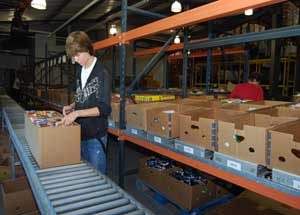Editorial
Front Page - Friday, December 18, 2009
Food bank bridging the gap between provisions and the hungry
David Laprad

Here’s how a child’s empty dinner plate is filled in Chattanooga:
Pillsbury, Kraft, General Mills or another local or national corporation tells Feed America, the largest domestic hunger relief charity in the U.S., it has food it’s not going to sell. Once Feed America has the provisions, it allocates them throughout its network, of which the Chattanooga Area Food Bank is a part.
After the supplies reach the Food Bank’s 41,000 square foot facility on Curtain Pole Road, they’re packed into boxes containing about $75 worth of groceries. While meeting with one of the social agencies in the Chattanooga area, the child’s mother mentions the difficulty she’s having feeding her family. The social worker in turn gives the woman a free voucher for one of the boxes, which contain enough provisions to cook several nutritionally balanced meals. The voucher costs the social agency $9.
After picking up the box at the Food Bank, the mother carries the supplies home, prepares a hot meal and places it in front of her child, who wolfs it down.
In another scenario, a charitable organization, such as a church, registers to become a member of the Food Bank, purchases groceries at the organization’s warehouse for 18 cents a pound and then distributes them to those in need. The arms of compassion that feed the hungry grow longer here, as church members generally donate the money to purchase the provisions.
Then there are the annual food drives, in which thousands of people from across the Chattanooga area purchase supplies and then drop them in a barrel or a box at a grocery store or a mall for the Food Bank to pick up.
The Food Bank will also send its trucks to area restaurants and grocery stores to pick up meals or groceries that won’t be served or sold, but are still good to eat, adding to its stores.
From the individual blessed with extra provisions, to the church or social service that has direct contact with those in need, to the Food Bank, to Feed America, to the businesses that donate supplies, many components work together to fill empty dinner plates in Chattanooga.
And there are plenty of plates to fill.
“We’re seeing increased demand,” says Clare Sawyer, executive director of the Food Bank. “It’s been rising for some time, but it’s escalated greatly in the last six months. Unemployment drives a lot of it.”
The good news, though, is that the Food Bank is rising to the occasion. In 2008, it shipped about 8.6 million pounds of groceries, and throughout 2009, its provisions have reached an average of 14,000 people per week. Its coverage area includes 11 counties in Tennessee and nine in Georgia.
Today, the towering shelves at the Food Bank might resemble
Mother Hubbard’s cupboard more than Sawyer would like, as the staff ships out supplies almost as soon as they come in, but people are getting fed, and that’s what counts.
“We’re meeting the demand. We’re not turning anyone away, and we haven’t cut down on the size of our boxes to do it,” she says. “But where we normally have enough food to put in storage, our shelves are empty.”
The Food Bank got its start in the early ’80s as a grassroots organization concerned about the growing number of hungry people in Chattanooga, many of which were approaching churches for groceries. Initially, the organization operated out of a rented warehouse on ML King Boulevard. After outgrowing that location and two others, the Food Bank built and moved into its current facility in 2006.
The size of the operation is considerable, with a staff of about 20 working to acquire, store and distribute provisions.
In addition to its voucher program and direct sales to charitable organizations, the Food Bank distributes supplies through a variety of ancillary programs.
By way of its Sack Pack program, for example, the organization gives elementary school children who are at-risk for hunger a bag of kid-friendly food for the weekend. During the 2006-07 school year, the Food Bank distributed 1,100 packs to 20 schools each week. Donors for the program include Firehouse Subs, McDonald’s, Coca-Cola and East Tennessee Box Company.
“We also have a new program called Rural Delivery, in which we send trucks packed with food to remote communities that don’t have access to our services,” Sawyer says.
There are other programs, some of which are expensive to maintain. By the end of 2009, the Food Bank will have purchased about $100,000 worth of the groceries it distributed throughout the year. So Sawyer says the organization is grateful when people provide financial assistance.
And when an individual makes a contribution, he automatically becomes a part of the arms of compassion that reach out to fill dinner plates in the Chattanooga area.
Visit www.chattfoodbank.org to learn more.
|
|